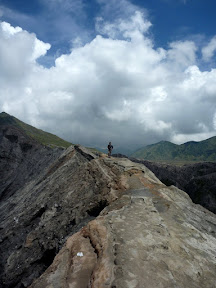
23-24 August 2010
I first learned of Bromo-Tengger-Semeru National Park (Bromo) when researching this trip. Chances are, reading this post, this is the first time you have heard of this ethereal landscape. I remember looking at the photo of Bromo in the front of the Indonesian Lonely Planet Guidebook and thinking two things; that is unreal and we have to go. Images you see of Bromo’s landscape are unlikely. You find yourself asking aloud, “Is that place on this earth?” Bromo really does look like a place you would find in some sci-fi movie. Upon arrival in Cemoro Lawang, the gateway to Bromo, you can only conclude that the images plastered on the walls of the restaurants and hotel lobbies must some kind of ruse. Maybe you get to see an image like that once a year or maybe you have to trek for three days to arrive at the best viewpoint… A few days ago we met a tourist who said, “We saw nothing but clouds at Bromo.”
This is what we half-expected to see when we rose at 3:30 in the morning and climbed into a Jeep, reeking of diesel, with four other tourists bound for Gunung (Indonesian for Mount) Penanjakan. Gunung Penanjakan, the best viewpoint for Bromo’s spectacular landscape, is reached by a 1-hour drive on an unpaved steep, narrow road. Our driver dropped us off and we began the 10-minute jaunt to the viewpoint. Let’s get this straight; this is not a wilderness experience. From the start you are pestered by touts selling food, hats, scarves (“it is cold up there, sir”), souvenir t-shirts, and entrepreneurs offering to rent windbreakers for 10,000 rupiah (about $1). One gets to share the viewpoint with well over 300 other tourists vying to get a perfect photo or two. The best vantage points, no ALL of the vantage points, are stacked at least four people deep. Upon arrival, the scene tempted us to turn around and go home. We searched unsuccessfully for an open spot, and then found ourselves climbing under a guard railing (safety first!). We then perched ourselves in perfect, unobstructed positions- clinging to the cliff’s edge. In the dim twilight we crossed our fingers for good weather.

From the moment we left our hotel room this morning it was very cloudy. The first thing I did was look up into the night sky and all I could see was the faint twinkle of a single star through the clouds and mist. We could barely see the road in front of us on the drive up the mountain. At the viewpoint, awaiting the sunrise, we stared at a dense, thick, white fogbank. The pessimist in me had completely set in as we sat in the cold darkness perched on the side of Gunung Penanjakan.
As the sun began to rise over East Java faint clouds on the horizon began to be illuminated and distant hills and sharp peaks revealed themselves gradually. Then, as the morning light first hit Bromo’s landscape, much to everyone’s amazement, the dense fogbank began to breakup. We felt a slight breeze and the high layer of fog and clouds covering the mountains, as if on cue, began to march westward. The sound of clicking shutters punctuated the twilight. Over the next hour or so the clouds and fog came and went, simultaneously revealing portions of Bromo’s landscape while shrouding others in crystal white. Words cannot describe the beauty of this landscape. In the foreground sits the intricately-fluted pyramid Gunung Batok. To the left and slightly beyond Gunung Batok is the famous Gunung Bromo, constantly emitting an enormous stream of white, sulfurous gas-its top blown off from a previous eruption. The landscape behind Gunung Bromo recedes into an intricate maze of ridges and peaks. Far off, the view is crowned by the massive, smoking pyramid of Gunung Semeru. To add to the scene’s drama the valley bottom was constantly cloaked in a low fog. This gave the appearance that this magical mountain scene was floating on a pillow of clouds.
In the early morning light we watched the changing clouds and photographed the beauty before us. As we walked down toward our Jeep, Rachel and I tried to determine if either of us had ever viewed a more dramatic landscape. Our conclusion was that the only place that might compete with Bromo is the Fitz Roy Range in Argentina. Needless to say, Bromo is one spectacular place.
We then headed down to take a short hike to the top of smoking Gunung Bromo. The day before, Rachel and I walked to the top of Gunung Bromo from Cemoro Lawang shortly before midday and, with the exception of the locals trying to sell us stuff (motorcycle rides, horseback rides, tea, snacks, trinkets, bouquets of flowers to throw into the volcano, etc…), we had the place nearly to ourselves. Today, as the crowds of people at the Gunung Penanjakan viewpoint are all on the same itinerary, the hike to the top of Gunung Bromo was a circus. We literally had to wade through dozens of wranglers offering us horseback rides, thousands of piles of horse shit, trinket sellers, and, of course, the hordes of tourists puffing their way up the mountain. Once again, this is not a wilderness experience. Nonetheless, looking down into the guts of Gunung Bromo for the second day in a row was still a spectacular experience. The sulfur smoke billows out in voluminous puffs, the air stinks of rotten eggs, tourists walk around the crater rim attempting to get the perfect photo, a local guy shoves a bouquet of dried flowers in your face (“10,000 rupiah, an offering to the gods”) while his colleagues wait just below the crater rim to re-collect any thrown bouquets. This is Java, baby!




